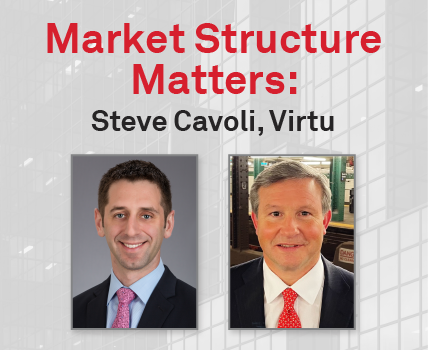“Our goal at Virtu Execution Services is to deliver a unified platform which enhances trader productivity across multiple asset classes globally.”
Steve Cavoli, Head of Execution Services at Virtu Financial, is clear about the firm’s place in the evolving capital markets ecosystem. “Our job is not to create a mini-Goldman Sachs or Morgan Stanley… Our heart is of a start-up and a disruptor, and that's what we want to do,” he said to Kevin McPartland, Head of Market Structure & Technology Research at Coalition Greenwich, in an interview at the New York Stock Exchange.
Virtu’s value proposition, according to Cavoli, is that “We are great technologists and what we want to do falls where big organizations either structurally can't deliver a product a service or they just don't want to. We're great micro-optimizers and detail-oriented folks with a great understanding of market structure and technology.”
Evolving to Stay Relevant
That’s gaining a premium in the face of rapid market structure changes and technological advances. Market participants must evolve to stay relevant.
Virtu’s ability to apply its “disciplined micro-optimization” to its expanding range of businesses—from liquidity sourcing to execution services to workflow technology platforms to data analytics—has enabled it to evolve, Cavoli believes. When he was 31, the West Point graduate moved from the infantry to join electronic trading firm Instinet. Later, after an 11-year stint at Morgan Stanley, he joined Virtu Financial, a firm founded by Vincent Viola, another West Pointer.
Scaling Up
Through several acquisitions, Virtu has gained scale and capabilities. For instance, the acquisition of rival high-frequency trader KCG Holdings’ in 2017 introduced Virtu to a client franchise. In addition to the retail business, it brought a “small institutional business” catering primarily to a handful of institutional asset managers and retail broker dealers in Europe investing in the U.S.
On the market making side of the business, Virtu also began taking a little more durational risk.. “That’s what the retail market maker gave us… [When] you're running a portfolio, you're running risk a little bit differently. We were more operational and hedging risk; now we had to move out on the curve,” he recounted.
Meanwhile, the ITG acquisition in 2018 expanded their institutional business and “provided a loyal client franchise, incredible products, and incredible reach globally. Now, we are a non-client market maker, a client market maker and an institutional broker that provides brokerage, automation, workflow technology, EMS, fixed network, commission management, and a huge and very powerful data analytics platform,” elaborated Cavoli, having focused on re-platforming ITG’s “great (products) onto brand new technology” over the last five years.
Interoperability is Key in a Fragmented Market
Both equity markets and technology platforms are facing increasing fragmentation, according to Cavoli. Hence, Virtu endeavors “to be a single platform end-to-end” covering the entire life cycle of a trade from pre-trade decision making to post-trade evaluation of that decision and everything in between.
The offering, he says needs to be on a single technology platform that can support all workflows. “You need an automation component, an RFQ component, a bilateral component, and an Algo component. That is the sum of our parts. Our value is that each of them work in complement to provide scale and deliver new products and services to our clients,” he elaborated.
This need for interoperability was top-of-mind when Virtu began its re-platforming exercise. “We are an agency broker, a high-touch desk, a PT [portfolio trading] desk, an ETF market-making desk—all that needs to be modular and interoperable so that we can pull it out and deliver it to our clients,” said Cavoli.
With 90–95% of the re-platforming done, his work is now focused on completing the migration and focusing on building solutions for clients while “we remain a small-culture mentality.”
The Data Challenge in Fixed Income
Meanwhile, with its EMS and analytics clients seeking fixed-income capabilities to put all their risk “through a single plane of glass,” Virtu made a measured entry into the institutional fixed-income business recently.
Is Virtu applying its equities learning to the fixed-income market? “The issue for our clients is we’re competing with the telephone [in fixed income]. In other areas, we’re competing with an Excel spreadsheet. When you start to apply automation technology and analytics, you have to know how to apply it to what asset class,” he asserted, for the data challenges in equities and fixed income differ dramatically. While data is immediate and ubiquitous in equities, “it is far more expensive, far less available and far more difficult to deal with in fixed income.”
While having complementary businesses can help absorb costs, since the data comes from multiple sources, it also needs to be cleaned, organized and enriched “with a trillion benchmarks. It would be folly to try to shoehorn an equity structure around something that doesn't work that way,” stated Cavoli.
Automating the Routine
Going forward, he believes the innovations will be more pedestrian and deal with making “the telephone and Excel spreadsheet more efficient” and solving the problem of traders having to swivel across multiple apps and data sources. “Automating the routine in a single end-to-end enterprise platform, a single data model across all workflows and asset classes across the globe—that is not intrinsically difficult, but it’s really hard to do,” he stated.
As for Virtu, it will continue to ensure that “the sum of our parts are far greater than the whole.”

